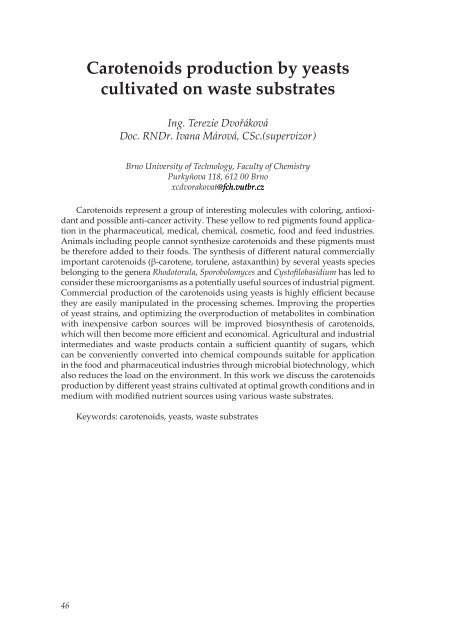Sborník abstraktů 2010 - Fakulta chemická - Vysoké učení technické ...
Sborník abstraktů 2010 - Fakulta chemická - Vysoké učení technické ...
Sborník abstraktů 2010 - Fakulta chemická - Vysoké učení technické ...
You also want an ePaper? Increase the reach of your titles
YUMPU automatically turns print PDFs into web optimized ePapers that Google loves.
Carotenoids production by yeasts<br />
cultivated on waste substrates<br />
Ing. Terezie Dvořáková<br />
Doc. RNDr. Ivana Márová, CSc.(supervizor)<br />
Brno University of Technology, Faculty of Chemistry<br />
Purkyňova 118, 612 00 Brno<br />
xcdvorakovat@fch.vutbr.cz<br />
@fch.vutbr.cz fch.vutbr.cz<br />
Carotenoids represent a group of interesting molecules with coloring, antioxidant<br />
and possible anti-cancer activity. These yellow to red pigments found application<br />
in the pharmaceutical, medical, chemical, cosmetic, food and feed industries.<br />
Animals including people cannot synthesize carotenoids and these pigments must<br />
be therefore added to their foods. The synthesis of different natural commercially<br />
important carotenoids (β-carotene, torulene, astaxanthin) by several yeasts species<br />
belonging to the genera Rhodotorula, Sporobolomyces and Cystofilobasidium has led to<br />
consider these microorganisms as a potentially useful sources of industrial pigment.<br />
Commercial production of the carotenoids using yeasts is highly efficient because<br />
they are easily manipulated in the processing schemes. Improving the properties<br />
of yeast strains, and optimizing the overproduction of metabolites in combination<br />
with inexpensive carbon sources will be improved biosynthesis of carotenoids,<br />
which will then become more efficient and economical. Agricultural and industrial<br />
intermediates and waste products contain a sufficient quantity of sugars, which<br />
can be conveniently converted into chemical compounds suitable for application<br />
in the food and pharmaceutical industries through microbial biotechnology, which<br />
also reduces the load on the environment. In this work we discuss the carotenoids<br />
production by different yeast strains cultivated at optimal growth conditions and in<br />
medium with modified nutrient sources using various waste substrates.<br />
Keywords: carotenoids, yeasts, waste substrates

















